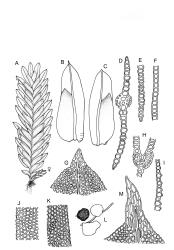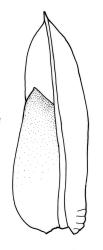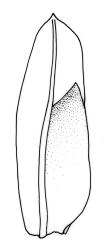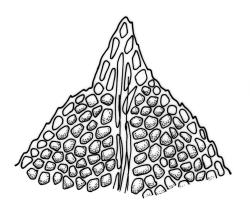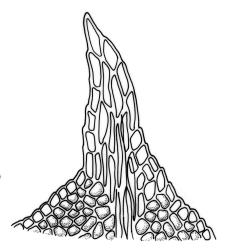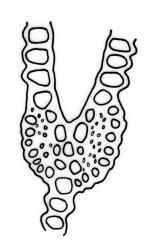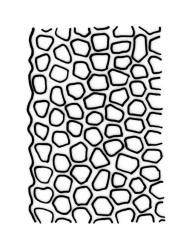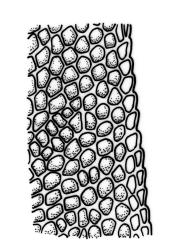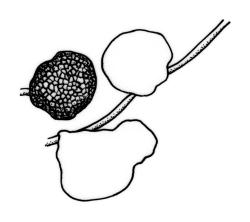Plants 5–10 mm, yellow-green to dark green, tufted, often densely gregarious. Stems branched from the base only, with rhizoids at base. Leaves in 10–15 pairs, slightly overlapping at mid stem, patent, plane when moist, irregularly and loosely inrolled in the distal third or little altered when dry, oblong-lanceolate, 1.4–2.4 × 0.4–0.8 mm; apex acute to broadly acute, mucronate to cuspidate on at least some leaves; laminae unistratose except for occasional pluristratose patches in the dorsal and apical laminae; vaginant laminae ½–⅔ leaf length, almost closed; dorsal lamina ending at leaf insertion or shortly decurrent, rounded and often undulate at base; margins serrulate; cells of apical and dorsal laminae quadrate to hexagonal, smooth, strongly bulging, with moderately thick walls, (6–)8–10(–12) × (6–)8–10(–12); cells of vaginant laminae occasionally bulging. Costa percurrent to excurrent as a mucro, taxifolius-type in cross-section. Rhizoidal tubers sometimes present, spherical to irregular, 150-380 µm diam., ≥20 cells across.
Dioicous. Perichaetia terminal on short shoots at base of sterile stems; perichaetial leaves reduced. Perigonia and capsules unknown in N.Z. material. Peristome taxifolius-type (in British material).
Crum & Anderson 1981, fig. 33, A–H; Beever & Stone 1992, fig. 1; Beever et al. 2002, p. 62, figs 1–6; Smith, 2004, fig. 77, 1–4; Bruggeman-Nannenga & Arts 2010, fig. 4.
In N.Z. F. taxifolius was, until recently, confused with F. asplenioides and F. oblongifolius, which are of similar size and also have unbordered leaves. It is, however, distinguished by its rigidly erect, tufted habit, and mucronate to cuspidate leaf apices with a percurrent to shortly excurrent costa (costa failing below the leaf apex in both F. asplenioides and F. oblongifolius). The undulate base of the dorsal lamina is often pronounced, and is diagnostic. In addition, short female shoots, produced at the base of sterile main stems, and often half hidden in the soil, are unique among N.Z. Fissidens.
K; NI: N Auckland, including offshore islands (LB, GB), S Auckland, Gisborne, Wellington; SI: Nelson, Marlborough, Otago; Ch.
Adventive. Nearly cosmopolitan, but not known from Australia.
Usually on soil, but occasionally on rock or concrete. Often lightly shaded in primarily exotic vegetation, such as urban parks and gardens. Records of F. taxifolius from native forest occur, but are so far confined to tracks. Associated mosses include Barbula convoluta, Bryum sauteri, Eurhynchium praelongum, Fissidens bryoides, F. curvatus, F. leptocladus, F. tenellus var. tenellus, Funaria hygrometrica, Racopilum robustum, Thuidiopsis furfurosa, and Tortula truncata.
Predominantly a lowland species, it has been recorded from near sea level to c. 400 m (Lake Rotokākahi, S Auckland L.D.).
Fissidens taxifolius is widespread and abundant in the north of the North I., with scattered localities further south. The earliest known N.Z. collection was made by William Martin from the Auckland Domain in 1944 (CHR 487011 & CHR 487012). Since a distribution map was published (Beever & Stone 1992) the species has been confirmed from urban Dunedin also. Previous South I. records were confined to Nelson and Marlborough. This extension of known range refutes the suggestion (Beever & Stone 1992) that distribution of F. taxifolius within N.Z. might be restricted by the requirement for a mild climate, but it provides support for the hypothesis that the species is adventive, and spread by humans.
Fissidens taxifolius has been found on Raoul I. (Kermadec Is), and on Chatham I., in both cases at single sites close to buildings. On both these outlier island groups eradication has been undertaken by Department of Conservation staff (de Lange & Beever, in press; de Lange et al. 2011). On Hauturu ō Toi/Little Barrier I. the moss is more widespread, having occasional records on tracks to an elevation of c. 275 m, as well as in the somewhat exotic garden of the Ranger, near sea level (Beever 2012).
Molecular data using nuclear ITS sequences (O. Werner, pers. comm., 16 Mar. 2012) indicate that seven N.Z. specimens are deeply nested within European specimens and fall into two groups, one from the North I. (AK 329750, Auckland Domain, N Auckland L.D.; AK 329841, Lake Hakanoa, Huntly township, S Auckland L.D.) and the other from the South I. (AK 334802, bank of Matai River, Nelson L.D.; H. Streimann 58303, NY, Hira State Forest, Nelson L.D.; AK 334799, Wakapuaka Cemetery, Nelson City, Nelson L.D.; AK 334798, Fairfield Park, Nelson City, Nelson L.D.; and AK 334800, Dunedin N Cemetery, Dunedin City, Otago L.D.). The two groups are separated by at least 15 mutations, which makes a single introduction event highly unlikely. Within the two groups there are minor sequence variations of one or two mutations.
The adventive occurrence of F. taxifolius in N.Z. is similar to that reported for the island of St Helena by Bruggeman-Nannenga & Wigginton (2012), where neither sporophytes nor male plants have been observed, and all known locations cited are within a single 1-km grid square encompassing anthropogenic sites.
Accounts of F. taxifolius in N.Z. were given by Beever & Stone (1992) and Beever (2012).




